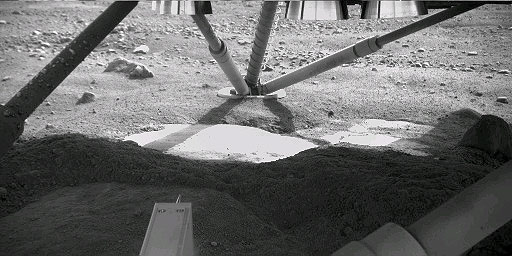New Images From Phoenix Lander May Show Martian Ice

NASA?s Phoenix Mars Lander may have already caught its first glimpse of Martianice less than a week after arriving at its new red planet home.
New images released Saturday reveal what could be a patch of exposedice beneath the Phoenix lander, mission managers said in an announcement today.Phoenix beamed the images back to Earth late Friday from its Vastitas Borealislanding site in the northern polar region of Mars after using a roboticarm-mounted camera to peer beneath its undercarriage.
The new views revealed patches of smooth, level surfaces beneath Phoenix?sthrusters, boosting the confidence of researchers who had hoped the spacecraft?spulse rocket engines could kick up the Martian topsoil to expose a buriedlayer of water ice.
"This suggests we have an ice table under a thin layerof loose soil," said Horst Uwe Keller, the lead scientist for Phoenix?s roboticarm camera at the Max Planck Institute for Solar System Research inKatlenburg-Lindau, Germany.
Phoenix, a stationary lander, setdown in the Martian arctic on May 25 to begin a planned three-month missionto probe its surroundings for buried water ice using a scoop-mounted robotic arm,as well as onboard ovens and wet chemistry lab. The probe?s $422 millionmission is aimed at determining whether the icy Martian north could have oncebeen habitable for primitive life.
"We were expecting to find ice within two to six inches of thesurface," said Phoenix principal investigator Peter Smith of theUniversity of Arizona in a statement. "The thrusters have excavated two tosix inches and, sure enough, we see something that looks like ice. It's notimpossible that it's something else, but our leading interpretation is ice."
Phoenix pulsed its rocket engines to make a three-point landing on abroad, flat valley in a region similar in latitude northwestern Canada onEarth. The area is in a region where spacecraft orbiting Mars have spottedindications of subsurface water ice in the past, making it a prime digging sitefor Phoenix?s robotic arm.
Get the Space.com Newsletter
Breaking space news, the latest updates on rocket launches, skywatching events and more!
NASA?s Phoenix spacecraft is one of three now currently operating on thesurface of Mars. The lander joined two twin robots, the Spirit and Opportunity rovers, whichlanded in 2004 and continue to explore different areas of the planet?s equatorialregions.
- Video: Sounds From Phoenix Mars Lander's Descent
- New Images: Phoenix on Mars!
- Video: The Nail-Biting Landing of Phoenix on Mars
Join our Space Forums to keep talking space on the latest missions, night sky and more! And if you have a news tip, correction or comment, let us know at: community@space.com.

Tariq is the Editor-in-Chief of Space.com and joined the team in 2001, first as an intern and staff writer, and later as an editor. He covers human spaceflight, exploration and space science, as well as skywatching and entertainment. He became Space.com's Managing Editor in 2009 and Editor-in-Chief in 2019. Before joining Space.com, Tariq was a staff reporter for The Los Angeles Times covering education and city beats in La Habra, Fullerton and Huntington Beach. In October 2022, Tariq received the Harry Kolcum Award for excellence in space reporting from the National Space Club Florida Committee. He is also an Eagle Scout (yes, he has the Space Exploration merit badge) and went to Space Camp four times as a kid and a fifth time as an adult. He has journalism degrees from the University of Southern California and New York University. You can find Tariq at Space.com and as the co-host to the This Week In Space podcast with space historian Rod Pyle on the TWiT network. To see his latest project, you can follow Tariq on Twitter @tariqjmalik.









